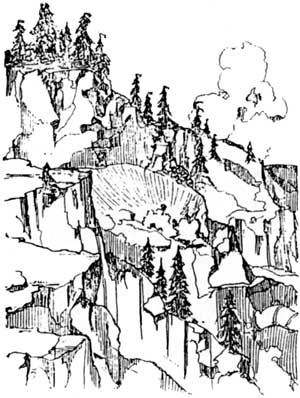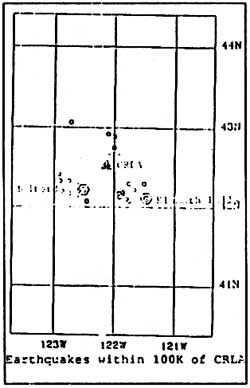Earthquakes in the Crater Lake Area
Since 1865, there have been 44 earthquakes within a 100 kilometer (62 mile) radius from the center of Crater Lake. The highest magnitude of any quake occurring within the 100 km circle during this period was 4.3 on the Richter Scale. This reading was obtained on three occasions over the past 125 years: period: in 1920 (38km from the lake), in 1931 (77km), and in 1948 (55km). There are no magnitude records for 15 quakes occurring within the circle. They include the closest one, a quake that took place in October 1947, just eleven kilometers from Crater Lake.
Crater Lake does not appear to be the center of any significant seismic activity over the past century. Not only were the magnitude readings of lesser intensity, but there were only three quakes during the period that had their epicenters closer than 20km from the center of the lake. The next five closest quakes ranged from 35 to 39 kilometers; other quakes were 45km or further from Crater Lake. Average distance of the earthquakes from the lake was 55 km.
One chart shows their spatial distribution, with the center of Crater Lake being 42.57 north latitude and 122.07 west longitude. The other charts delineate epicenter distance from the park and quake magnitude.
Biodiversity in Red Blanket Canyon
Virtually all of the canyons in Crater Lake National Park are worth exploring. Many contain pinnacles or other interesting geological formations, but all of them are good hikes. As stream habitats, they harbor a greater diversity of life than the meadows, nonriparian forests, or pumice fields. The term biological diversity has been used to express the variety and variability among living organisms and the ecological complexes in which they occur. Diversity can be defined as the number of different items and their relative frequency. These items are organized at many levels, ranging from complete ecosystems (ecosystem diversity) to the chemical structures that are the molecular basis of heredity (genetic diversity).
Between ecosystem and genetic diversity lies species diversity, which refers to the variety of living organisms on earth. The most commonly accepted definition of a species is a population of organisms that can at least potentially breed with one another but that do not breed with other populations. Species diversity is a function of what the surrounding habitat allows. Wetlands and streams have long been known to harbor the greatest species diversity among the various habitat types. This is particularly evident as one hikes along the streams within Crater Lake National Park. For example, one could contrast the stream that originates at Boundary Springs with the adjacent lodgepole pine (Pinus contorta) forest.
Of all the habitats within Crater Lake National Park, species diversity is greatest in Red Blanket Canyon. Only a small fraction of the canyon is within the park’s boundaries, but this is an environment very different from the subalpine, snow-adapted forest of Mountain hemlock (Tsuga mertsensiana) and true firs (Abies concolor, A. Iasiocarpa,and the A. magnifica-procera complex) that dominate so much of the park. The 4200 foot elevation of the park’s southwest corner is suitable for the growth and development of a mixed conifer forest. Its presence in the vicinity of Red Blanket Canyon was largely determined before 1900 through historic fire disturbances and the habitat type common to the Prospect area.
Some of the forest at the lower elevations in the canyon can be labeled old-growth, the kind of forest which once dominated the area between the Pacific Ocean and the crest of Oregon’s Cascade Range. Exact ecological definitions for these forests remain elusive, yet several of their structural components are easily discernable: large live trees, large snags, large logs on the ground, and large logs in streams. Greater structural diversity is evident than in younger stands, as old-growth trees have a much greater range of diameters, tend toward more heterogeneous spacing, and exhibit greater patchiness with respect to their understory vegetation.
The upper three miles of Red Blanket Canyon have a different species composition and function than the heavily logged forests of the lower Red Blanket drainage and the Prospect Flat area. As an old-growth forest, the upper canyon also displays differences in the rate and paths of energy flow. Likewise, it is distinct from stands further downstream in water and nutrient cycling. Maintenance of a large conifer overstory is critical to the survival of species not found in the younger forests, such as the Northern spotted owl (Strix occidentalis caurina) and the Pacific yew (Taxus brevifolia). These species are fairly easy to discern and relatively large, characteristics which have been used as indicators in gauging the health of an increasingly fragmented life support system.
Red Blanket Canyon is accessible from Prospect or by using the trail system in Crater Lake National Park south of Highway 62. Most visitors go east of Prospect on Red Blanket Road to Forest Service Road 6205. The head of the canyon is roughly four miles up the gravel road, past a gate which is closed during the winter months. As one proceeds toward the Red Blanket trailhead located at road’s end, several regenerating clearcuts are periodically apparent near the stream. Roughly two miles short of the Red Blanket trailhead is a sign marking one end of the Varmint trail, which climbs through an old-growth forest and up the canyon’s north wall. Lightly used, the Varmint trail allows hikers to see the last roadless area adjacent to Crater Lake National Park not having legal wilderness designation.
The southwest corner of the park is encountered within a half mile of the Red Blanket trailhead. At just over 4,000 feet in elevation, the corner marker is located in a lush old-growth forest. The trail straddles the park boundary for its first mile and a quarter, generally staying above Red Blanket Creek but occasionally beckoning the walker to explore small tributary drainages on the canyon’s north side. The most prominent stream drains the southwest slope of Union Peak, which is an unseen promontory from the canyon floor.

Karl J. Belser in Blue Interval, Ernest G. Moll, Metropolitan Press, Portland, 1935.
In its second mile, the Red Blanket trail veers away from the park and hugs a side of the creek as the canyon narrows. Red Blanket Falls is one of the most spectacular places in the Sky Lakes Wilderness, an area adjacent to the park and is under national forest administration. At an elevation of about 5,000 feet, the falls are the head of Red Blanket Canyon. The transition to a subalpine forest where prolonged snow conditions are the rule is apparent once out of the canyon. As hikers continue along the trail toward Stuart Falls and the park boundary, trees are more often twisted into the pronounced L-shape so common along the Cascade Divide.
There are fewer resident plant and animal species at the higher elevations, largely because of the approximately one degree celsius decrease in average annual temperature for every thousand feet gained in elevation. Yet a hiker will more often obtain sweeping views of the surrounding area. Bald Top is one of the points in the park from where the entirety of Red Blanket Canyon can be seen. Little known even among park rangers, Bald Top is a product of the once active Union Peak volcano. That volcano preceded Mazama and its glaciers carved Red Blanket Canyon, as evidenced by the distinctive U-shape. The other canyons in the park are more recent and bear the mark of Mount Mazama’s climactic eruption to a far more obvious degree. Nevertheless, they also play a important role in perpetuating the biodiversity of the greater Mount Mazama ecosystem.


